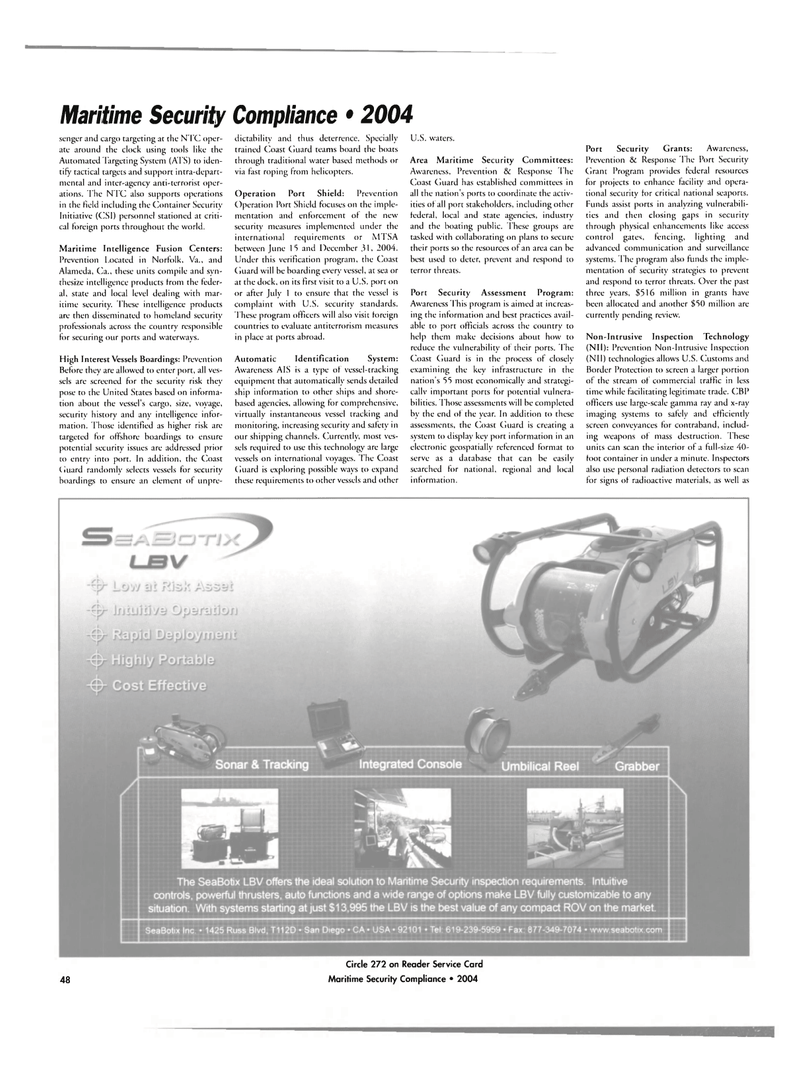
Page 48: of Maritime Reporter Magazine (July 2004)
Gulf of Mexico: Floating Production Systems & Support Vessels
Read this page in Pdf, Flash or Html5 edition of July 2004 Maritime Reporter Magazine
Maritime Security Compliance • 2004 senger and cargo targeting at the NTC oper- ate around the clock using tools like the
Automated Targeting System (ATS) to iden- tify tactical targets and support intra-depart- mcntal and inter-agency anti-terrorist oper- ations. The NTC also supports operations in the Field including the Container Security
Initiative (CSI) personnel stationed at criti- cal foreign ports throughout the world.
Maritime Intelligence Fusion Centers:
Prevention Located in Norfolk, Va., and
Alameda, Ca., these units compile and syn- thesize intelligence products from the feder- al, state and local level dealing with mar- itime security. These intelligence products are then disseminated to homeland security professionals across the country responsible for securing our ports and waterways.
High Interest Vessels Boardings: Prevention
Before they are allowed to enter port, all ves- sels are screened for the security risk they pose to the United States based on informa- tion about the vessel's cargo, size, voyage, security history and any intelligence infor- mation. Those identified as higher risk are targeted for offshore boardings to ensure potential security issues are addressed prior to entry into port. In addition, the Coast
Cluard randomly selects vessels for security boardings to ensure an element of unpre- dictability and thus deterrence. Specially trained Coast Guard teams board the boats through traditional water based methods or via fast roping from helicopters.
Operation Port Shield: Prevention
Operation Port Shield focuses on the imple- mentation and enforcement of the new security measures implemented under the international requirements or MTSA between June 15 and December 31, 2004.
Under this verification program, the Coast
Guard will be boarding every vessel, at sea or at the dock, on its first visit to a U.S. port on or after July 1 to ensure that the vessel is complaint with U.S. security standards.
T hese program officers will also visit foreign countries to evaluate antiterrorism measures in place at ports abroad.
Automatic Identification System:
Awareness AIS is a type of vessel-tracking equipment that automatically sends detailed ship information to other ships and shore- based agencies, allowing for comprehensive, virtually instantaneous vessel tracking and monitoring, increasing security and safety in our shipping channels. Currently, most ves- sels required to use this technology are large vessels on international voyages. T he Coast
Guard is exploring possible ways to expand these requirements to other vessels and other
U.S. waters.
Area Maritime Security Committees:
Awareness, Prevention & Response The
Coast Guard has established committees in all the nation's ports to coordinate the activ- ities of all port stakeholders, including other federal, local and state agencies, industry and the boating public. These groups are tasked with collaborating on plans to secure their ports so the resources of an area can be best used to deter, prevent and respond to terror threats.
Port Security Assessment Program:
Awareness This program is aimed at increas- ing the information and best practices avail- able to port officials across the country to help them make decisions about how to reduce the vulnerability of their ports. The
Coast Guard is in the process of closely examining the key infrastructure in the nation's 55 most economically and strategi- cally important ports for potential vulnera- bilities. Those assessments will be completed by the end of the year. In addition to these assessments, the Coast Guard is creating a system to display key port information in an electronic geospatially referenced format to serve as a database that can be easily searched for national, regional and local information.
Port Security Grants: Awareness,
Prevention & Response The Port Security
Grant Program provides federal resources for projects to enhance facility and opera- tional security for critical national seaports.
Funds assist ports in analyzing vulnerabili- ties and then closing gaps in security through physical enhancements like access control gates, fencing, lighting and advanced communication and surveillance systems. The program also funds the imple- mentation of security strategies to prevent and respond to terror threats. Over the past three years, $516 million in grants have been allocated and another $50 million are currently pending review.
Non-Intrusive Inspection Technology (Nil): Prevention Non-Intrusive Inspection (Nil) technologies allows U.S. Customs and
Border Protection to screen a larger portion of the stream of commercial traffic in less time while facilitating legitimate trade. CBP officers use large-scale gamma ray and x-ray imaging systems to safely and efficiently screen conveyances for contraband, includ- ing weapons of mass destruction. These units can scan the interior of a full-size 40- foot container in under a minute. Inspectors also use personal radiation detectors to scan for signs of radioactive materials, as well as
Circle 272 on Reader Service Card 48 Maritime Security Compliance • 2004

 47
47

 49
49
